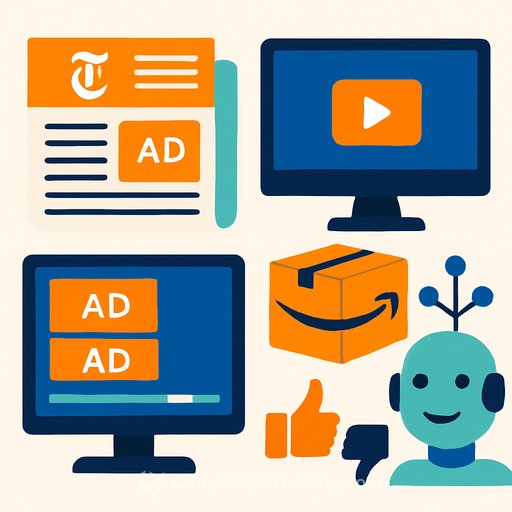Kantar US Media Reactions 2025: What Marketers Need to Know for 2026
Kantar's latest Media Reactions study surfaces a clear message: ad context and creative fit now decide performance. US consumers are more open to ads this year (58% vs. 47% in 2024), yet fewer than one in three marketers feel confident their ads are consistently customized for each channel.
Smart money goes where receptivity is highest and creative can fit the format. As Kantar's team puts it, creative adapted to the media environment drives stronger short- and long-term results.
US platforms where consumers are most receptive to ads
- 1. The New York Times
- 2. Amazon
- 3. Apple TV
- 4. Netflix
- 5. X
US platforms marketers prefer
- 1. YouTube
- 2. Netflix
- 3. Disney+
- 4. Instagram
- 5. Prime Video
Global rankings at a glance
Consumers:
- 1. Amazon
- 2. Snapchat
- 3. TikTok
- 4. Twitch (NEW)
- 5. Prime Video (NEW)
Marketers:
- 1. YouTube
- 2. Instagram
- 3. Google
- 4. Netflix
- 5. Spotify
Budget tension: where spend is going vs. what people want
Over half of marketers plan to increase budgets in podcasts, video streaming, and other targeted digital channels. Consumers, however, show stronger preference for out-of-home (OOH), sponsorships, and online publications.
- Shift a portion of incremental budget into high-receptivity channels (OOH, sponsorships, quality online publications) while maintaining streaming/video where creative can truly fit the format.
- Require a channel-specific creative plan for every buy. No more one-size-fits-all cutdowns.
Demographic signals that matter
- Hispanic consumers: higher receptivity to Online Video and Social Media Stories; lower response to Influencer Content and Music Streaming.
- Males, Gen Y, and Gen Z: more open to generative AI in ads than other groups.
- Hispanic consumers: less concern about AI-generated ads (about one-third report distrust) vs. over half of US consumers.
- Campaigns are 7x more impactful among receptive audiences-prioritize segments and contexts where your category already has permission.
AI in advertising: usage up, trust lags
- 70%+ of marketers are using generative AI for creative work; 40% rank it a top-three priority.
- About half of consumers enjoy AI-generated visuals, yet 60%+ worry about fake or misleading ads.
- 70%+ of marketers value AI predictions to assess creatives that might go untested; 80%+ agree early creative testing improves outcomes.
- Adopt clear labeling and brand safety rules for AI assets. Earn trust with transparency.
- Use AI to expand concept exploration, then validate with pre-testing and consistent measurement.
- Target AI-led creative to receptive segments first (Gen Y/Z, certain multicultural audiences) while monitoring sentiment closely.
Practical plan for 2026
- Prioritize channels with proven ad equity in your category: premium news, retail media, and streaming environments noted in the study.
- Build modular creative systems that flex by placement (length, vertical vs. horizontal, interactive vs. passive).
- Institute an always-on test-and-learn loop: early-stage creative checks, iterative updates, and post-campaign readouts.
- Use AI for versioning, concepting, and prediction-paired with human review and clear disclosure.
- Balance the mix: don't ignore OOH, sponsorships, and credible online publications despite the digital bias in many plans.
Methodology (for context)
21,300 consumers aged 16-65 across 30 markets (covering ~90% of media spend) were surveyed from May-August 2025. 974 senior marketers were surveyed from April-June 2025.
Get the full study
Access Kantar's Media Reactions 2025 report and webinar here: Kantar Media Reactions.
Upskill your team on AI for marketing
If you're formalizing AI workflows, these resources can help your team build practical skills:
Your membership also unlocks:






